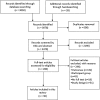Treatment of obesity, with a dietary component, and eating disorder risk in children and adolescents: A systematic review with meta-analysis
- PMID: 31131531
- PMCID: PMC6851692
- DOI: 10.1111/obr.12866
Treatment of obesity, with a dietary component, and eating disorder risk in children and adolescents: A systematic review with meta-analysis
Abstract
This review aimed to investigate the impact of obesity treatment, with a dietary component, on eating disorder (ED) prevalence, ED risk, and related symptoms in children and adolescents with overweight or obesity. Four databases were searched to identify pediatric obesity treatment interventions, with a dietary component, and validated pre-post intervention assessment of related outcomes. Of 3078 articles screened, 36 met inclusion criteria, with a combined sample of 2589 participants aged 7.8 to 16.9 years. Intervention duration ranged from 1 week to 13 months, with follow-up of 6 months to 6 years from baseline. Prevalence of ED was reported in five studies and was reduced post-intervention. Meta-analyses showed a reduction in bulimic symptoms (eight studies, standardized mean difference [SE], -0.326 [0.09], P < 0.001), emotional eating (six studies, -0.149 [0.06], P = 0.008), binge eating (three studies, -0.588 [0.10], P < 0.001), and drive for thinness (three studies, -0.167 [0.06], P = 0.005) post-intervention. At follow-up, a reduction in ED risk (six studies, -0.313 [0.13], P = 0.012), emotional eating (five studies, -0.259 [0.05], P < 0.001), eating concern (three studies, -0.501 [0.06], P < 0.001), and drive for thinness (two studies, -0.375 [0.07], P < 0.001) was found. Structured and professionally run obesity treatment was associated with reduced ED prevalence, ED risk, and symptoms.
Keywords: dieting; disordered eating; pediatrics; weight loss.
© 2019 The Authors. Obesity Reviews published by John Wiley & Sons Ltd on behalf of World Obesity Federation.
Conflict of interest statement
Authors have no conflict of interest.
Figures







Comment in
-
A response to the comments by Ms Adams on our paper "Treatment of obesity, with a dietary component, and eating disorder risk in children and adolescents: A systematic review with meta-analysis".Obes Rev. 2020 Mar;21(3):e12971. doi: 10.1111/obr.12971. Epub 2019 Nov 8. Obes Rev. 2020. PMID: 31702109 No abstract available.
-
Letter to the editor: Concerns regarding "Meta-analysis on pediatric obesity treatments and eating disorder risk" of Jebeile et al.Obes Rev. 2020 Mar;21(3):e12968. doi: 10.1111/obr.12968. Epub 2019 Nov 10. Obes Rev. 2020. PMID: 31709725 No abstract available.
References
-
- Abarca‐Gómez L, Abdeen ZA, Hamid ZA, et al. Worldwide trends in body‐mass index, underweight, overweight, and obesity from 1975 to 2016: a pooled analysis of 2416 population‐based measurement studies in 128·9 million children, adolescents, and adults. Lancet. 2017;390(10113):2627‐2642. - PMC - PubMed
-
- Steinbeck KS, Lister NB, Gow ML, Baur LA. Treatment of adolescent obesity. Nat Rev Endocrinol. 2018;14(6):331‐344. - PubMed
-
- Pinhas‐Hamiel OD, Zeitler PMD. Acute and chronic complications of type 2 diabetes mellitus in children and adolescents. Lancet. 2007;369(9575):1823‐1831. - PubMed
Publication types
MeSH terms
LinkOut - more resources
Full Text Sources
Medical
Miscellaneous

